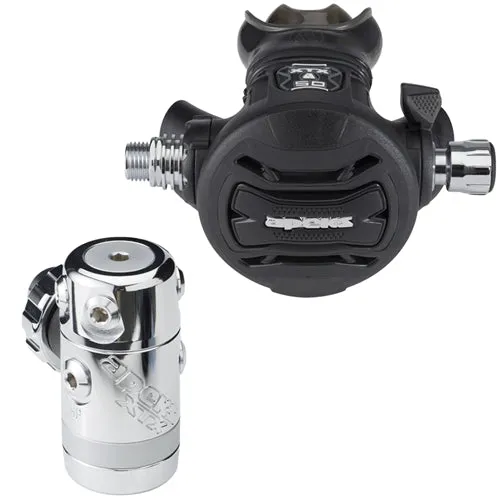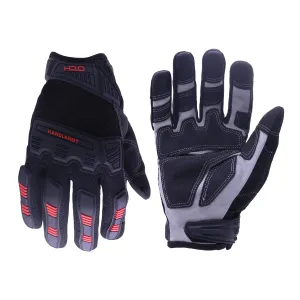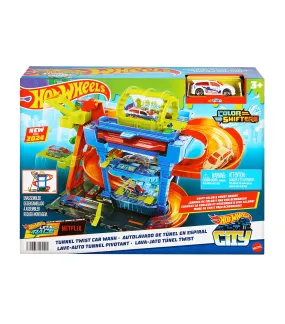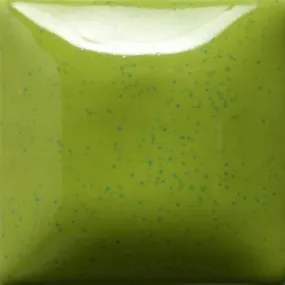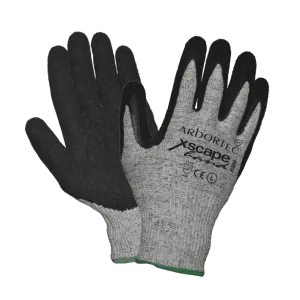This popular first stage has four medium-pressure ports all mounted on a rotating turret. This results in optimal hose routing while eliminating sharp bends in the hose
Features an innovative Diver Changeable Exhaust system (DCE). This system gives the diver the ability to change from a small exhaust tee to a large exhaust tee. This gives the user a choice, wider exhaust tee for minimal bubble interference (essential for underwater photography) and narrow exhaust tee for a smaller compact comfortable regulator. The regulator will be supplied with both sets of exhaust tees
Optional 5th port is available for sidemount or twin cylinder set ups.
Can be converted from a right-handed hose configuration to a left-handed one. The process of changing the regulator to a left-handed configuration is both quick and simple. However this procedure MUST only be performed by an APEKS Authorized Service Technician
Available in yoke or din configuration
Braided flexi-hoses are now standard on all models. These hoses are lighter weight, more flexible and more durable
Suitable for coldwater use
Compatible with EAN40 out of the box
First Stage:
- Unique over-balanced, diaphragm design - as the diver descends, the over-balancing feature allows the medium pressure gas in the hose to increase at a rate faster than ambient. This results in superior performance at depth.
- 2 HP ports and 4 MP ports are angled for optimum hose routing
- An environmental dry system keeps water out of the main spring chamber thus preventing ice buildup and keeping silt and contamination out
Second Stage:
- Pneumatically-balanced second stage results in smooth, easy breathing
- The XTX purge buttons are large and easy to operate. A 2-stage progressive purge is used. Press the purge on the side for a lower flow rate, useful where more control is required such as filling lift bags etc, then press in the center for the full effect of the purge, i.e. when regulator clearing etc.
- The large venturi lever has a soft touch rubber grip, which makes it easier to locate and use. The lever reduces the amount of grit ingress and therefore resists any possible friction giving a smooth operation.
- Easy-to-grip opening effort control knob keeps the diver in control
- The 2nd stage is manufactured with active protection against infection as all molded parts are produced with an additive that kills MRSA, protects against E-Coli, bacteria and fungi, and is also very effective against viruses, mould, yeast and algae.
- A silicone exhaust valve improves the breathing performance of the regulator
- The Comfo-bite™ mouthpiece virtually eliminates jaw-fatigue
- A heat exchanger (patented) which surrounds the valve mechanism, dissipates the cold caused by gas expansion while drawing in the warmth of the ambient water
Specs
- Connections DIN
- Type of first stage Over-balanced diaphragm design, environmentally sealed
- Body Type MP ports mounted on swivel turret
- Number of HP ports 2 (7/16" UNF)
- Number of MP ports 4 with 5th port option (3/8" UNF)
- Environmental Dry Kit Standard
- First stage exterior Chrome over marine brass
- Orientation Convertible LH or RH
- Coldwater Use Yes
- Type of second stage pneumatically balanced
- Opening Effort Control Knob Yes
- Integrated Venturi Lever Yes
- Mouthpiece Comfo-bite™
- Exhaust tee Diver Changeable - comes with 2 sets
- Heat Exchanger for freezing resistance Yes
- Hose type Braided Flexi-hose
- Overall work of breathing (WOB) scores Avg. 0.70 joules/liter
- Nitrox compatible Yes to 40% O2 when new, out of the box / Can be O2 cleaned to 100%
- Weight Yoke 1269g / DIN 1139g
Advantages of a DIN First Stage
DIN first stages are nifty devices that pack a punch when it comes to enhancing your underwater experience. One of the standout benefits is their superior sealing capability. Thanks to their threaded connection, DIN first stages create a rock-solid seal that keeps water out and air in, even at extreme depths. They also offer excellent durability. The robust design means they can take a beating and keep on ticking, perfect for those rough-and-tumble dive adventures. And let's not forget about versatility. DIN first stages are compatible with a wide range of tanks, giving you more options for your dive setup. Plus, they're known for their consistent performance across various scuba diving conditions, from tropical waters to icy depths.
Why a Regulator DIN Over a Yoke
When it comes to choosing between a DIN and a yoke regulator, the DIN often comes out on top for serious divers. Why? Well, it all boils down to performance and reliability. DIN regulators offer a more secure connection to your tank, which is crucial when exploring the depths. This tight seal reduces the risk of leaks, giving you peace of mind during your dive. But there's more to it than just security. DIN regulators are typically more compact and streamlined, reducing drag as you glide through the water. They're also ideal for technical diving and cold water adventures, where every bit of reliability counts. And here's a little-known fact: DIN regulators typically allow for higher working pressures, which can be a game-changer for deep dives or when using special gas mixes. A yoke valve may have its place, but if you're looking to take your diving to the next level, a DIN regulator might just be what you're looking for.
The Function of a First-Stage Scuba Regulator
First-stage scuba regulators are clever devices that sit right on your tank and are ready to spring into action. Its primary job is to take the high-pressure air from your tank and bring it down to a more manageable intermediate pressure. But how does it pull off this feat? Inside the first stage, you'll find a complex system of valves and springs that respond to the surrounding water pressure. As you descend and the pressure increases, the first stage adjusts accordingly, maintaining a constant intermediate pressure. This ensures that your second stage (the part you breathe from) always has the right amount of air to deliver. The first stage also distributes air to other equipment like your BCD or dry suit.
The Function of a Second-Stage Scuba Regulator
The second-stage scuba regulator is your direct connection to the underwater world. It takes the intermediate pressure air from the first stage and reduces it further to ambient pressure, also known as the pressure of the surrounding water. The second stage is also designed to deliver air on demand, responding to even the slightest inhale. When you breathe in, a valve opens, allowing air to flow. When you exhale, another valve directs your breath out into the water. This may sound simple, but it's a delicate balance of pressures and mechanics. Modern second stages often include features like adjustable inhalation effort or venturi switches, allowing you to fine-tune your breathing experience. Some even have special exhaust valves to reduce bubbles, perfect for underwater photography or observing marine life.
Get the Apeks XTX50 Regulator DIN From Scubadelphia Diveseekers
The Apeks XTX50 Regulator DIN is calling your name! This scuba first-stage regulator combines all the benefits we've discussed. Its innovative Diver Changeable Exhaust system (DCE) lets you customize your exhaust based on your diving style or conditions. Planning a side-mount or twin-cylinder adventure? The optional 5th port has you covered.
At Scubadelphia Diveseekers, we're passionate about equipping you with the best. So why stop at the regulator? Check out our for your rebreather needs or the for that perfect fit. Your next great dive is waiting.

